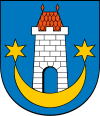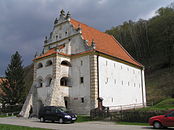Kazimierz Dolny
| Kazimierz Dolny | |||
|---|---|---|---|

Kazimierz Dolny - View of the town
|
|||
|
|||
| Coordinates: 51°19′20″N 21°56′51″E / 51.32222°N 21.94750°E | |||
| Country | |||
| Voivodeship | Lublin | ||
| County | Puławy | ||
| Gmina | Kazimierz Dolny | ||
| Government | |||
| • Mayor | Andrzej Pisula | ||
| Area | |||
| • Total | 30.44 km2 (11.75 sq mi) | ||
| Population (2006) | |||
| • Total | 3,572 | ||
| • Density | 120/km2 (300/sq mi) | ||
| Time zone | CET (UTC+1) | ||
| • Summer (DST) | CEST (UTC+2) | ||
| Postal code | 24-120 | ||
| Car plates | LPU | ||
| Website | kazimierzdolny.pl | ||
Kazimierz Dolny ([kaˈʑimʲɛʂ ˈdɔlnɨ] Yiddish: קאזמיר Kuzmir) is a small town in central eastern Poland, on the right (eastern) bank of the Vistula river in Puławy County, Lublin Voivodeship. Historically it belongs to Lesser Poland, and in the past it used to be one of the most important cities of the province.
It is a considerable tourist attraction as one of the most beautifully situated little towns in Poland. It enjoyed its greatest prosperity in the 16th and the first half of the 17th century, due to the trade in grain conducted along the Vistula. It became an economic backwater after that trade declined, and this freeze in economic development enabled the town to preserve its Renaissance urban plan and appearance. Since the 19th century it has become a popular holiday destination, attracting artists and summer residents.
Kazimierz Dolny is an art center in Poland. Many painters retreat to this small town to paint and sell their work. Galleries can be found in almost every street, offering for sale sculptures, stained-glass, folk art, and fine art.
The town is one of Poland's official national Historic Monuments (Pomnik historii), as designated September 16, 1994 and tracked by the National Heritage Board of Poland.
Location[edit]
Kazimierz Dolny is located on the eastern bank of the Vistula, at the edge of historical Lublin Upland extending further east from Małopolska Upland to the west. It owes its picturesque location to the Lesser Polish Gorge of the Vistula. The town is part of the so-called tourist triangle Puławy – Kazimierz Dolny – Nałęczów. It does not have a rail connection, the nearest station is located in Puławy (Puławy - Miasto).
History[edit]
The history of Kazimierz Dolny dates back to the 11th century, when on one of the local hills there was a Benedictine settlement called Wietrzna Gora. In 1181, Prince Casimir II the Just handed the settlement to Norbertine nuns from Kraków’s district of Zwierzyniec. The nuns changed its name to Kazimierz, in honor of the prince. For the first time, the name Kazimierz appears in chronicles in 1249. Later on, the adjective Dolny (Lower) was added, to distinguish the town from the Jewish town Kazimierz - now a district of Kraków. In the early 14th century, the village became a royal possession, and King Władysław I the Elbow-high founded there a parish church in 1325.
The foundation of the town is attributed to Władysław's son, King Casimir III the Great, who granted the town rights in the first half of the 14th century. Later, King Władysław II Jagiełło modernized Kazimierz Dolny, creating a modern town, with a market square and streets. At that time, the decision was taken not to build any houses on the northern side of the market square, so as not to obstruct the view of the church and the castle.
In 1501, Kazimierz Dolny became the home of a starosta, and the town was passed over to the noble Firlej family, remaining in its hands until 1644. The Firlejs twice rebuilt the town and the castle, after the fires of 1561 and 1585. They cared about privileged status of Kazimierz Dolny, as a merchant town, located along the busy waterway of the Vistula. In 1628, Franciscan monks settled in Kazimierz, building a monastery and expanding the church.
The town's golden age ended in February 1656 (see Deluge), when Swedish troops under King Charles X Gustav burned and ransacked it. The number of inhabitants declined, and King John III Sobieski tried to improve the situation, by allowing in 1677 Armenian, Greek and Jewish merchants to settle there. Meanwhile, the profitable Vistula river trade came to an end, as there was no demand for Polish grains in Western Europe. In the late 18th century, as a result of the Partitions of Poland, Kazimierz Dolny was cut from the port of Gdańsk and turned into a town of minor importance.
From the late 19th century, more affluent residents of Lublin and Warsaw started to build properties in the area. Spas and villas were constructed, and in 1927, already in the Second Polish Republic, Kazimierz Dolny once again became a town. Partly destroyed in World War II, it was rebuilt, and on September 8, 1994, its center was officially recognized as a historical monument.
Points of interest[edit]
- Parish church of St. Bartholomew and John the Baptist (1586-1589), with 1620 organs, and 1615 pulpit,
- St. Anne church (1671) and Holy Spirit hospital (1635),
- Church of St. Mary (1589) and monastery (1638–68),
- Ruins of the castle (14th - 16th century),
- Defensive tower (13th or 14th century),
- Several houses by the architect Karol Siciński, including one built by Kazimierz Ołdakowski
- Tenement houses (early 17th century),
- Several historic granaries (16th and 17th centuries).
- Synagogue.
Kazimierz Dolny has been the location of several films, mainly for youth. Among people associated with the town are Jacek Bromski, Chaim Goldberg, and Daniel Olbrychski.
Jewish life[edit]
A small Jewish community was present in the city from the time of Casimir III the Great in the 14th century. The king granted the Jews a writ of rights which caused the town to become a focal point for Jewish immigration. When John III Sobieski became King in 1674, he granted the Jews of Poland a respite from taxes. Sobieski also reconfirmed for the Jews all the rights they had been granted by previous kings. During his reign, the housing restrictions were abolished and the Jewish community began to flourish again.
In the 19th century, Yehezkel Taub, a disciple of the "Seer of Lublin", founded the Hasidic dynasty of Kuzmir in the town.
Between the First and Second World Wars, the Jewish population was about 1,400, half the total population of the town. During the Holocaust era, a Judenrat was established in the town, where the Nazi Germans forced the town's Jews to perform forced labor and to pave roads using tombstones from the local Jewish cemetery. After the Holocaust, a memorial wall was erected using the pieces that survived. In 1940, the Germans established a ghetto, bringing all the Jews from the surrounding Puławy County to live in the ghetto. In 1942, the Jews that survived the starvation, disease and slave labor were taken to Belzec to be "exterminated". At the end of 1942, the town was officially declared "free of Jews".
One of the most famous Jewish residents of the town was the painter and sculptor Chaim Goldberg. Another was the noted journalist S. L. Shneiderman, who wrote about Kazimierz Dolny in his book The River Remembers.
-
Market square in Kazimierz Dolny in 1899, watercolor and pencil on cardboard - painting by Stanisław Masłowski
External links[edit]
| Wikimedia Commons has media related to Kazimierz Dolny. |
- Information from About.com: Eastern Europe Travel
- Picture of the Holocaust memorial wall
- Pictures of the town from the site of Yad Vashem, the Jewish Holocaust memorial organization
- Home page for noted journalist, S. L. Shneiderman
- [1] Home page of the painter Chaim Goldberg, who was born in the village and who made its depiction during the period of 1930-1939 his life's mission. He painted from memory after that.












